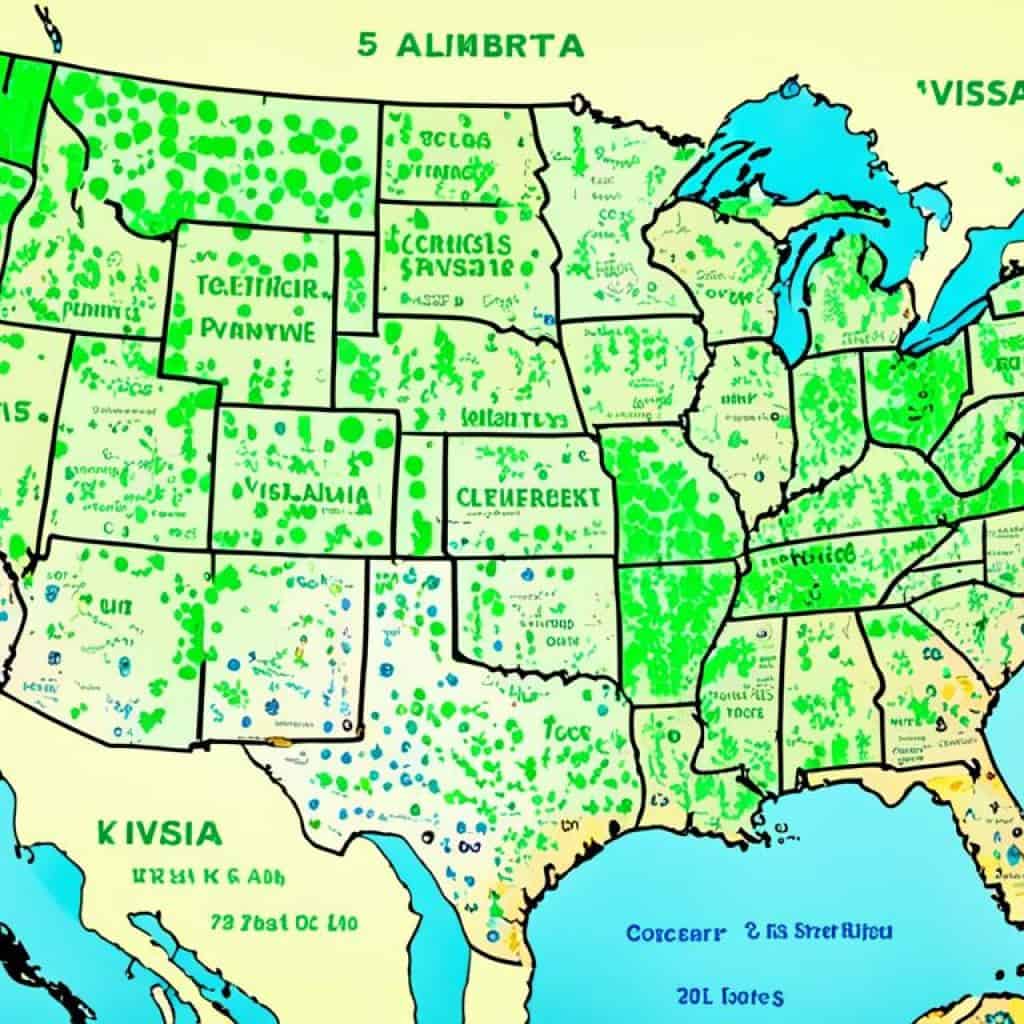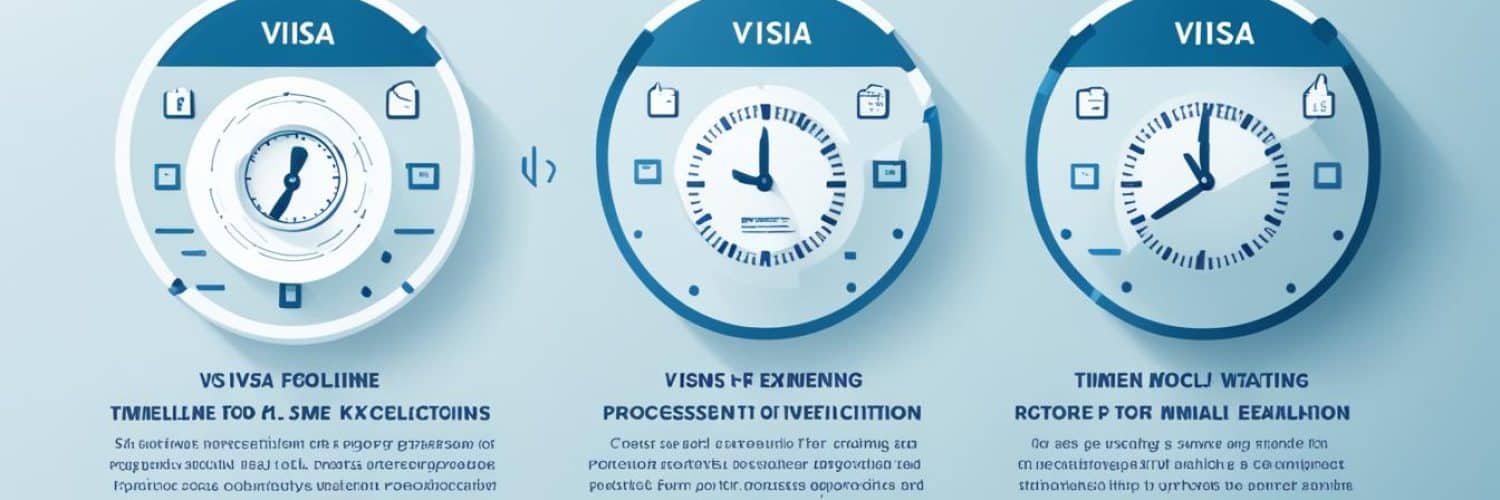Are you considering applying for a K1 visa in 2022? Wondering how long it will take for your visa to be processed?
Well, you’ve come to the right place! In this article, we will provide you with all the current insights on the K1 visa processing time for this year. Whether you’re planning to bring your fiancé to the United States or you’ve already submitted your application, understanding the processing time is crucial for proper planning and preparation.
From the impact of the COVID-19 pandemic to the factors affecting the timeline, we will cover everything you need to know about the K1 visa processing time in 2022.
So, let’s dive in and discover the latest information that will help you navigate the K1 visa journey with confidence!
Key Takeaways:
- The processing time for the K1 visa can vary, but it typically takes between 12 to 18 months.
- Delays may occur due to application backlog and the impact of the COVID-19 pandemic.
- It is essential to stay updated on the factors that affect the processing time and to plan accordingly.
- Expedited processing may be possible in certain cases, but it is not guaranteed.
- Understanding the historical importance of the K1 visa can provide insights into its significance.
K1 Visa Timeline 2022: Step-by-Step Guide
The process of obtaining a K1 visa involves several steps that must be completed in a specific sequence. Understanding the K1 visa timeline is crucial to ensure a smooth and successful application process. Here is a step-by-step guide to help you navigate the timeline for 2022:
- Filing the I-129F Petition: The first step is to file the I-129F petition with the United States Citizenship and Immigration Services (USCIS). This form serves as the official request to bring your foreign fiancé(e) to the U.S. The processing time for this step can vary, but it typically takes around 8 to 10 months to receive a decision from USCIS.
- Approval of the I-129F Petition: After submitting the I-129F petition, you will need to wait for its approval. Once approved, USCIS will forward the case to the National Visa Center (NVC) for further processing. The approval of the petition can take anywhere from a few weeks to several months.
- Scheduling and Attending the Visa Interview: Once the NVC receives the approved petition, they will assign a case number and forward it to the U.S. Embassy or Consulate in your fiancé(e)’s home country. You will then have to schedule and attend the visa interview at the designated embassy or consulate. The wait time for the interview appointment can vary depending on the location, but it is generally around 2 to 4 months.
- Entering the U.S. and Getting Married: If the visa interview is successful, your fiancé(e) will receive the K1 visa allowing entry into the United States. Once your fiancé(e) arrives in the U.S., you have 90 days to get married. It is important to plan your wedding accordingly and ensure that all necessary preparations are made within this timeframe.
During each step of the K1 visa timeline, it is essential to stay informed and keep track of any updates or changes in the processing times. Factors such as the workload of the immigration agencies and the embassy or consulate where the visa interview will occur can influence the processing time for each step. By understanding the timeline and preparing in advance, you can increase your chances of a successful K1 visa application.
K1 Visa Processing Time 2022: Factors Affecting the Timeline
Several factors can affect the processing time for the K1 visa in 2022. It’s crucial to understand these factors and manage your expectations accordingly. Let’s explore the key elements that contribute to the K1 visa processing time.
- Backlog of Applications: The number of pending K1 visa applications can significantly impact the processing time. If there is a backlog of cases awaiting review, it may prolong the overall timeline. It’s important to stay updated on the average processing time based on the current backlog and plan your application accordingly.
- COVID-19 Pandemic Impact: The COVID-19 pandemic has disrupted immigration processes worldwide, including embassy and consular operations. These disruptions can affect the timeline for processing K1 visas. It’s prudent to consider potential delays and stay informed about any changes in embassy and consular operations.
- Changes in Immigration Policies or Procedures: Any alterations to immigration policies or procedures can also impact the processing time for the K1 visa. Ensure that you stay updated on any policy changes and adapt your application accordingly to avoid unnecessary delays.
Submitting all required documents and forms accurately and in a timely manner is essential to avoid any additional processing delays. Providing complete and well-prepared applications can help expedite the processing time.

By understanding the factors affecting the K1 visa processing time in 2022, you can navigate the application process more effectively. Stay informed, be proactive, and consult with experienced immigration lawyers to ensure a smooth and timely processing of your K1 visa application.
Expedited K1 Visa Processing Time 2022
In certain cases, applicants may have the option to expedite the processing time for their K1 visa in 2022. Expedited processing is available for situations that meet specific criteria, such as humanitarian emergencies or urgent business travel. It provides a way to prioritize the visa application and facilitate a quicker decision.
To request expedited processing, applicants need to provide supporting documentation and demonstrate a valid reason for the expedited request. This documentation could include medical records, travel itineraries, or business contracts, depending on the nature of the request. It is crucial to provide sufficient evidence to support the urgency of the situation.
However, it is important to note that not all expedited requests are granted. The decision to expedite the processing time is ultimately made at the discretion of the immigration authorities. Each case is evaluated individually, and the validity of the reason for expedited processing is carefully considered.
Applicants should also keep in mind that while expedited processing can help to accelerate the timeline, it does not guarantee an immediate approval. The processing time will still depend on various factors, including the workload of the immigration agencies and the embassy or consulate processing the visa application.
For those who believe they have a genuine reason to request expedited processing, it is advisable to consult with an experienced immigration lawyer. They can provide guidance on the required documentation, help prepare a strong case for expedited processing, and navigate the intricacies of the application process. Their expertise can increase the chances of a successful request and minimize any potential delays.
Remember, expedited processing for the K1 visa is reserved for exceptional circumstances based on valid reasons. It is important to ensure that the request meets the necessary criteria and is supported by appropriate documentation.
Situations that may qualify for expedited processing:
- Humanitarian emergencies
- Urgent medical needs
- Imminent travel due to family or personal emergencies
- Immediate business obligations
Applicants should carefully assess their situation and consult with an immigration lawyer to determine if they meet the criteria for expedited processing. Acting promptly and providing compelling evidence can help to expedite the processing time and bring applicants closer to their desired outcome.
Expert's tip:
“If you believe you have a valid reason for expedited processing, consult with an immigration lawyer to understand the requirements and increase your chances of success. They can guide you through the application process and help present a strong case for expediting your K1 visa processing time.”
Having an image relevant to expedited K1 visa processing time 2022 adds visual appeal and enhances the reader’s engagement with the content.
K1 Visa Processing Time at USCIS 2022
The processing time for the K1 visa at USCIS (United States Citizenship and Immigration Services) can vary. On average, it takes approximately 10.5 to 19 months for the I-129F petition, the first step in the K1 visa application process, to be processed. However, the processing time can be affected by factors such as the workload of the USCIS service center handling the petition and any changes in immigration policies or procedures.
It is important to stay informed and monitor the USCIS processing times to have a realistic expectation of the timeline for your K1 visa application. By understanding the potential delays and factors that can affect the processing time, you can plan ahead and prepare all the necessary documentation and forms to ensure a smooth application process.
Here are some key points to keep in mind:
- Processing time can vary between USCIS service centers.
- Changes in immigration policies or procedures can impact processing times.
- Be proactive and stay updated on the USCIS processing times for your specific service center.
- Plan ahead and submit all required documents accurately and in a timely manner.
Remember, patience and preparation are key when navigating the K1 visa application process. By staying informed and organized, you can increase the chances of a successful visa application and be one step closer to reuniting with your loved one in the United States.
Impact of COVID-19 on K1 Visa Processing Time 2022
The COVID-19 pandemic has significantly affected the processing time for the K1 visa in 2022. As a result of the pandemic, there have been delays in embassy and consular operations, leading to longer processing times for visa applications. Additionally, changes in immigration policies and procedures have been implemented to prioritize the health and safety of applicants and immigration officers.
These measures have been put in place to mitigate the risks associated with the virus and ensure a smooth and efficient visa application process. However, it is important to acknowledge that these changes can contribute to potential delays.
Adapting to the Changing Landscape
During these challenging times, it is essential to remain patient and resilient throughout the K1 visa application process. Here are some key considerations to help navigate the impact of COVID-19:
- Monitor official announcements from the U.S. Department of State and U.S. Citizenship and Immigration Services (USCIS) for any updates or changes to the visa application process.
- Regularly check the embassy or consulate’s website where your visa interview will take place for any specific instructions or requirements related to COVID-19 protocols.
- Ensure all necessary documentation is prepared accurately and promptly to avoid any unnecessary delays.
- Consider consulting with an experienced immigration lawyer who can provide guidance and support tailored to your unique circumstances.
By staying proactive and informed, you can navigate the challenges posed by the pandemic and increase your chances of a successful K1 visa application.
In times of uncertainty, it is important to remain resilient and adaptable. While the processing time for the K1 visa may be affected by the ongoing pandemic, remember that love knows no boundaries, and together, you can overcome any obstacles along the way.
Throughout the K1 visa journey, it is crucial to prioritize the health and safety of yourself and your loved ones. By taking necessary precautions and staying informed, you can navigate the process with confidence and look forward to starting your new life together in the United States.
Historical Importance of the K1 Visa
The K1 visa holds immense historical importance as it has continuously facilitated the reunion of families and the development of international relationships since its inception in 1952. Over the years, the K1 visa program has undergone significant reforms, refining the process and ensuring its effectiveness in bringing engaged couples together.
The K1 visa offers a unique pathway for couples to join hands, celebrate their love, and establish their lives in the United States. What sets the K1 visa program apart is its recognition of the emotional significance of weddings by allowing couples to be physically present during the planning and celebration, strengthening their bonds and forming a solid foundation for their future.
By gaining a deeper understanding of the historical importance of the K1 visa, applicants can truly appreciate the significance of the process and the range of opportunities it provides. Let’s delve into the journey of the K1 visa and explore its transformative role in the lives of countless couples around the world.

| Year | Key Milestones |
|---|---|
| 1952 | Introduction of the K1 visa |
| 1967 | Implementation of the Alien Fiancée’s Immigrant Visa (K1 visa) category |
| 1986 | Passage of the Immigration Marriage Fraud Amendments Act, streamlining the process and adding additional security measures |
| 1998 | Introduction of the “One-Year Bar Rule” to prevent serial K1 visa petitions |
| 2001 | Creation of a dedicated K1 visa unit within the United States Citizenship and Immigration Services (USCIS) |
| 2010 | Implementation of the International Marriage Broker Regulation Act (IMBRA) to protect the rights and safety of K1 visa applicants |
| 2022 | The K1 visa continues to be a vital pathway for engaged couples to unite and build their lives together |
âThe K1 visa is a testament to the enduring power of love and the willingness of nations to support and foster relationships across borders.â
Through its humanitarian aspects, the K1 visa celebrates the union of souls, making it more than just a legal process. The historical significance of the K1 visa resonates in the hearts of countless couples who have embarked on this journey of love and commitment. As applicants enter the K1 visa process, they step into a rich history that has helped bring families together and create lasting international bonds.
Comparison of K1 Visa with Other Visa Types
When comparing the K1 visa with other nonimmigrant visa types, it becomes clear that the number of K1 visa admissions in 2022 accounted for only 0.3% of all nonimmigrant visas. This indicates the relatively smaller number of annual issuances for the K1 visa compared to other visa types.
One example of a visa type with significantly higher annual admissions is the B-1/B-2 travel visa. The B-1/B-2 visa is a popular choice for individuals visiting the United States for tourism, business, or medical treatment purposes.
| Visa Type | Annual Admissions |
|---|---|
| K1 Visa | 0.3% |
| B-1/B-2 Travel Visa | Higher percentage |
It is essential to be aware of the differences and unique characteristics of the K1 visa compared to other visa types. Understanding these distinctions will help applicants and their sponsors navigate the application process and grasp the specific processing time and requirements associated with the K1 visa.
Nationality Shifts in K1 Visa Recipients
In recent years, there have been notable shifts in the nationalities of K1 visa recipients. Post-pandemic, there has been a decrease in K visa recipients from countries such as Vietnam, Great Britain/Northern Ireland, China, and Brazil. On the other hand, the numbers for the Philippines and Mexico are approaching pre-pandemic levels. These shifts in nationality can be attributed to various factors, including travel restrictions, changes in immigration policies, and economic conditions.
As travel limitations and COVID-19-related challenges persist, it is crucial for applicants to stay informed about the changing landscape of K1 visa popularity among different nationalities. By being aware of these shifts, individuals can better understand the potential impact on processing times and anticipate any adjustments that may need to be made during the application process.
Factors Influencing Nationality Shifts
- Travel Restrictions: The implementation of travel bans and restrictions due to the pandemic has significantly affected the ability of individuals from certain countries to apply for K1 visas.
- Changes in Immigration Policies: Alterations in immigration policies and regulations have had a direct impact on the number of K1 visa recipients from specific countries.
- Economic Conditions: Economic fluctuations and changes in job opportunities may influence the decision of individuals from different countries to pursue a K1 visa.
Understanding the trends in nationality shifts is vital for applicants to navigate the K1 visa application process effectively. By staying informed about current visa recipient demographics, individuals can better prepare for potential processing time variations and address any specific requirements or challenges associated with their country of origin.
| Nationality | Decrease in K1 Visa Recipients | Increase in K1 Visa Recipients |
|---|---|---|
| Vietnam | â | |
| Great Britain/Northern Ireland | â | |
| China | â | |
| Brazil | â | |
| Philippines | Approaching pre-pandemic levels | |
| Mexico | Approaching pre-pandemic levels |
Note: The table above outlines the notable changes in nationality for K1 visa recipients. The checked boxes represent a decrease in visa recipients from specific countries, while the “Approaching pre-pandemic levels” indicates an increase in visa recipients from the Philippines and Mexico.
Top Destination States for K1 Visa Holders in 2022
When it comes to choosing a destination in the United States for K1 visa holders, certain states have emerged as top choices in 2022. Among these states, California, Texas, Florida, and New York have been the most popular. According to data from Boundless and RapidVisa K1 customers, a significant 36% of K1 visa sponsors listed one of these states as their current home.
The popularity of these states among K1 visa holders can be attributed to various factors that make them attractive destinations. Firstly, these states offer abundant job opportunities across a wide range of industries, making it easier for K1 visa holders to establish their careers and build a stable life. Secondly, these states are known for their diverse and vibrant cultural scenes, providing K1 visa holders with a chance to experience a rich tapestry of traditions, festivals, and cuisines. Lastly, these states boast well-established communities of both immigrants and nonimmigrants, creating a supportive environment for K1 visa holders to connect, build relationships, and thrive.
Considering the destination state is crucial when planning the K1 visa application process and making arrangements for the future. It is important to take into account factors such as job prospects, cultural experiences, community support, and the overall quality of life when selecting a destination. By carefully considering these factors, K1 visa holders can ensure a smooth transition and a fulfilling life in their chosen state.

| State | Percentage of K1 Visa Holders |
|---|---|
| California | 19% |
| Texas | 9% |
| Florida | 6% |
| New York | 2% |
Table: Top Destination States for K1 Visa Holders in 2022
Impact of â90-Day Fiancéâ on K1 Visa Processing Time 2022
The reality television series “90-Day Fiancé” has had a significant impact on the K1 visa process. Since its debut, the show has gained immense popularity and has brought increased attention to the K1 visa application process. As a result, there has been a noticeable drop in approval rates for K1 visas, with 2022 seeing the lowest rate since USCIS started reporting the data.
The widespread viewership of “90-Day Fiancé” has influenced perceptions and expectations about the K1 visa process. Many individuals have become familiar with the complexities and challenges that couples face when navigating the K1 visa application journey. However, it is crucial to understand that the show’s impact on the K1 visa processing time is multi-faceted and complex.
While some couples may draw inspiration from the show and decide to pursue the K1 visa, others may face unrealistic expectations due to the entertainment nature of the program. The show primarily focuses on the dramatic aspects of the K1 visa process, often portraying the challenges and conflicts that couples encounter. This can lead to misconceptions about the actual timeline and requirements for obtaining a K1 visa.
It is important to note that the processing time for a K1 visa is primarily determined by factors such as the workload of the immigration agencies, backlog of applications, and any changes in immigration policies or procedures. While “90-Day Fiancé” has brought attention to the K1 visa, it is crucial to approach the process with accurate information and an understanding of the real-life complexities involved.
Applicants should rely on official sources such as the United States Citizenship and Immigration Services (USCIS) for accurate and up-to-date information regarding the K1 visa application process. Seeking guidance from experienced immigration lawyers can also provide valuable insights and support throughout the journey.
By staying informed, managing expectations, and approaching the process with realistic timelines, couples can navigate the K1 visa application process successfully and reunite with their loved ones in the United States.
Conclusion
Navigating the K1 visa application process can be complex and time-consuming, especially with the impact of the COVID-19 pandemic and the various factors that can affect the processing time. It is important to stay informed, plan ahead, and be prepared for potential delays.
Utilizing the services of experienced immigration lawyers can provide guidance and support throughout the process. These professionals have in-depth knowledge of the K1 visa requirements and can help couples understand the complexities of the application. They can also assist in submitting accurate and complete documentation, increasing the likelihood of a successful application.
By understanding the K1 visa processing time and requirements, couples can streamline their journey towards joining their loved ones in the USA and starting their life together. Staying up-to-date with any changes in immigration policies and procedures is crucial. Couples should also be proactive in gathering the necessary paperwork, such as proof of relationship, financial support, and medical examinations, to avoid any unnecessary delays.
While the K1 visa application process may present challenges, it is important to remain positive and focused on the end goal of being together. With careful planning, appropriate resources, and the guidance of professionals, couples can navigate through the complexities of the K1 visa application process and look forward to building a future together in the United States.
FAQ
What is the average processing time for a K1 visa in 2022?
The processing time for a K1 visa can vary, but it typically takes between 12 to 18 months. However, there may be delays due to the backlog of applications and the impact of the COVID-19 pandemic.
What are the steps in the K1 visa timeline?
The K1 visa timeline consists of filing the I-129F petition, waiting for its approval, scheduling and attending the visa interview, and entering the U.S. and getting married within 90 days.
What factors can affect the processing time for a K1 visa in 2022?
Factors that can affect the processing time include the backlog of applications, the impact of the COVID-19 pandemic, and any changes in immigration policies or procedures.
Is it possible to expedite the processing time for a K1 visa?
Yes, it may be possible to expedite the processing time for a K1 visa in certain cases. Expedited processing is typically reserved for situations that meet specific criteria, and a valid reason must be provided along with supporting documentation.
How long does it take for the K1 visa to be processed at USCIS?
On average, it takes approximately 10.5 to 19 months for the I-129F petition, the first step in the K1 visa application process, to be processed at USCIS. However, the processing time can be affected by various factors.
How has the COVID-19 pandemic impacted the processing time for K1 visas in 2022?
The COVID-19 pandemic has resulted in delays in embassy and consular operations, leading to longer processing times for K1 visas. Changes in immigration policies and procedures have also been implemented to ensure the health and safety of applicants and immigration officers.
What is the historical importance of the K1 visa?
The K1 visa has a rich history and has played a significant role in reuniting families and fostering international relationships since its introduction in 1952.
How does the K1 visa compare to other visa types?
The number of K1 visa admissions in 2022 accounted for only 0.3% of all nonimmigrant visas. It is important to understand the unique characteristics of the K1 visa compared to other visa types.
Have there been any shifts in the nationalities of K1 visa recipients in recent years?
Yes, there have been shifts in the nationalities of K1 visa recipients, which can be attributed to factors such as travel restrictions, changes in immigration policies, and economic conditions.
What are the top destination states for K1 visa holders in 2022?
According to data from Boundless and RapidVisa K1 customers, the top destination states for K1 visa holders in 2022 were California, Texas, Florida, and New York.
What impact has the television series “90-Day Fiancé” had on the K1 visa processing time in 2022?
Since the debut of “90-Day Fiancé,” there has been a noticeable drop in approval rates for K1 visas. The show’s influence on the processing time is complex, and there are other factors at play as well.








Add comment